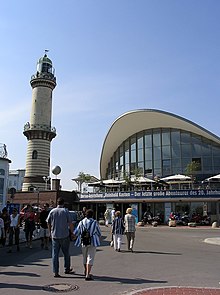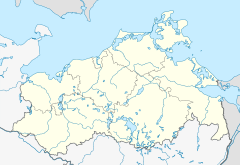Warnemünde Lighthouse

Lighthouse and Teapot
|
|
| Location |
Warnemünde, Western Baltic Sea Germany |
|---|---|
| Coordinates | 54°10′53.1″N 12°05′08.8″E / 54.181417°N 12.085778°ECoordinates: 54°10′53.1″N 12°05′08.8″E / 54.181417°N 12.085778°E |
| Year first constructed | 1836 (first) |
| Year first lit | 1898 (current) |
| Automated | 1978 |
| Foundation | 33 pillars |
| Construction | glazed white brick |
| Tower shape | tapered cylindrical tower with lantern and two galleries |
| Markings / pattern | unpainted tower, green copper lantern dome |
| Height | 36.9 metres (121 ft) |
| Focal height | 34 metres (112 ft) |
| Original lens | Fresnel lens |
| Range | 20 nautical miles (37 km) |
| Characteristic | Fl (3+1) W 24s. |
| Admiralty number | C1404 |
| NGA number | 3428 |
| ARLHS number | FED-022 |
| Managing agent | Förderverein Leuchtturm Warnemünde |
| Heritage |
Kulturdenkmal |
|
[]
|
|
Warnemünde Lighthouse is a lighthouse situated on the estuary of the Warnow river in Warnemünde, a district in the borough of . The lighthouse has a height of 36.9 metres (121 ft) and was put into service in 1898.
In 1862 it was decided to replace the old 8-metre-high stormlamp in Warnemünde with a new lighthouse. The construction of the lighthouse was officially approved in 1863, however, as a result of serious disagreement between its financiers, the town of Rostock, the district administrator (estates of the country: parliament of patricians and knights) and the Mecklenburg railways (the latter had owned the ferry boat route to Gedser in Denmark since 1886), the project did not actually start until 1897. It was commissioned one year later in October 1898. The building was planned and erected by the director of harbour construction, Friedrich Kerner.
33 posts were piled 11 metres deep into the earth to act as the foundation. The lighthouse has two cellars and the part above ground is 31 metres high and built of glazed white brick and a number of bands of green brick. The tower has two galleries used as panoramic viewing platforms for visitors.
In the early years, the lighthouse lamp used petroleum and later gas to generate its light. To begin with, the rotating Fresnel lens assembly was propelled by clockwork, driven by a heavy iron weight sliding down a steel tube in the centre of the tower. Every evening, the lighthouse keeper had first to pump 90 litres of petroleum up to a tank at the top and then wind the weight up every two hours. Since 1927 it has operated electrically. The beam has an angle of over 180° and is focused by mirror reflectors on the land side. The light can be seen at a distance of about 20 nautical miles (37 km).
The light characteristic or light pattern, which enables the identification of the lighthouse, is: 0,3 fl. -2,7 dark -0,3 fl. -2,7 dark -0,3 fl. -8,7 dark -0,3 fl. -8,7 dark. Each sequence lasts 24 seconds.
Warnemünde Lighthouse
Warnemünde Lighthouse
...
Wikipedia

